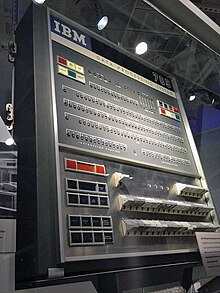IBM 709

TheIBM 709is acomputersystem that was initially announced byIBMin January 1957[1]and first installed during August 1958.[2][3][4]The 709 was an improved version of its predecessor, theIBM 704,and was the third of theIBM 700/7000 seriesof scientific computers. The improvements included overlapped input/output,indirect addressing,and three "convert" instructions which provided support fordecimalarithmetic, leading zero suppression, and several other operations. The 709 had 32,768 words of36-bitmagnetic core memoryand could execute 42,000 add or subtract instructions per second. It could multiply two 36-bit integers at a rate of 5000 per second.[5]
An optional hardwareemulatorexecuted old IBM 704 programs on the IBM 709. This was the first commercially available emulator. Registers and most 704 instructions were emulated in 709 hardware. Complex 704 instructions such as floating-point trap and input-output routines were emulated in 709 software.
TheFORTRAN Assembly Programwas introduced for the 709.
It was a large system; customer installations used 100 to 250 kW to run them and almost as much again on the cooling. It weighed about 2,110 pounds (960 kg) (without peripheral equipment).[6] The 709 was built usingvacuum tubes.
IBM announced a transistorized version of the 709, called theIBM 7090,in 1958, only a year after the announcement of the 709, thus cutting short the 709's product life.
Registers
[edit]
| |||||||||||||||||||||||||||||||||||||||||||||||||||||||||||||||||||||||||||||||||||||||||||||||||||||||||||||||||||||||||||||||||||||||||||||||||||||||||||||||||||||
The IBM 709 has a 38-bit accumulator, a 36-bit multiplier/quotient register, and three 15-bitindex registerswhose contents are subtracted from the base address instead of being added to it. All three index registers can participate in an instruction: the 3-bittagfield in the instruction is a bit map specifying which of the registers participate in the operation, however if more than one index register is specified, their contents are combined by alogical oroperation, not addition.[7]p. 12
Instruction and data formats
[edit]There are five instruction formats, referred to as Types A, B, C, D and E.[7]Most instructions are of type B.[8]
Type A instructions have, in sequence, a 3-bitprefix(instruction code), a 15-bitdecrementfield, a 3-bittagfield, and a 15-bitaddressfield. They are conditional jump operations based on the values in the decrement registers specified in thetagfield. Some also subtract thedecrementfield from the contents of the index registers. The implementation requires that the second two bits of the instruction code be non-zero, giving a total of six possible type A instructions. One (STR, instruction code binary 101) was not implemented until the IBM 709.
Type B instructions have, in sequence, a 12-bit instruction code (with the second and third bits set to 0 to distinguish them from type A instructions), a 2-bitflagfield, four unused bits, a 3-bittagfield, and a 15-bitaddressfield.
Types C, D and E are used for specialized instructions.
- Fixed-point numbers are stored in binarysign/magnitude format.
- Single-precisionfloating-pointnumbers have a sign, an 8-bit excess-128 exponent and a 27-bit fraction (there was no "hidden bit" ).
- Alphanumeric characters are 6-bitBCD,packed six to a word.
The instruction set implicitly subdivides the data format into the same fields as type A instructions: prefix, decrement, tag and address. Instructions exist to modify each of these fields in a data word without changing the remainder of the word.
I/O channel
[edit]The primary improvements of the 709 over the previous 704 involved more magnetic-core memory and apparently the first use of independent I/O channels. Whereas I/O on 704 is a programmed function of the central processor - data words are transferred to or from the I/O register, one at a time, using a "copy" instruction - the 709 uses the IBM-766 data synchronizer, which provides two independently "programmed" I/O channels. Up to three Data Synchronizers can be attached to a 709, each able to control up to 20IBM 729tape drives and anIBM 716alphanumeric line printer,IBM 711card-reader and 721 card punch. This allows six times as many I/O devices on 709, and allows I/O to proceed on multiple devices while program execution continues in parallel. Up to two IBM 733Magnetic Drumunits, each with 8,192 words of memory, could be attached independently from the Data Synchronizers. The 709 could initially load programs (boot) from card, tape or drum.[7]: 113
TheIBM 738Magnetic Core Storage used on the 709 was also a milestone of hybrid technology. Although the core array drivers all used vacuum tubes, the read sense amplifiers were a very early use of transistors in computing.
See also
[edit]- List of vacuum tube computers
- IBM 740CRT recorder
- SHARE Operating System(SOS)
- SQUOZE
References
[edit]- ^Fisher, Franklin M.; McKie, James W.; Mancke, Richard B. (October 1983).IBM and the U.S. data processing industry: an economic history.Praeger. p. 37.ISBN9780030630590.
- ^Schulz, Peter R. (1970).The Composition of the Computer Market: Past, Present, Future: a Report.Stanford-Sloan Program, Graduate School of Business, Stanford University. p. 8.
- ^Chapin, Ned (1963).An introduction to automatic computers.Van Nostrand. p. 192.
- ^"WDPC Negotiations".personal.anderson.ucla.edu.September 16, 1958: The IBM 709 computer arrives (26 tons of iron). Archived fromthe originalon 2006-09-12.Retrieved2018-01-21.
Use of the big computer, second of its type to come off the assembly line, is being given to the WDPC (...)
{{cite web}}:CS1 maint: others (link) - ^IBM 709 at Columbia University history page
- ^IBM 709 Data Processing SystemBRL report, (details of each installation) with photos
- ^abcIBM 709 Reference Manual, Form A22-6501-0, 1958
- ^John Savard."From the IBM 704 to the IBM 7094".Retrieved2009-11-15.
Further reading
[edit]- Sherman, Philip M. (1963). Written atBell Telephone Laboratories,Murray Hill, New Jersey, USA.Programming and Coding the IBM 709-7090-7094 Computers(PDF)(1 ed.). New York / London / Sydney:John Wiley & Sons, Inc.Archived(PDF)from the original on 2020-06-18.Retrieved2020-06-18.
External links
[edit]- 709 Data Processing System– IBM history
- IBM 709 Data Processing System– BRL report, (details of each installation) with photos
- IBM 709 page at Columbia University– with photos
